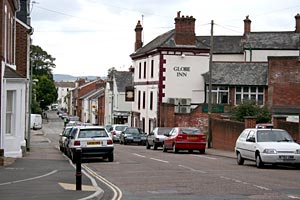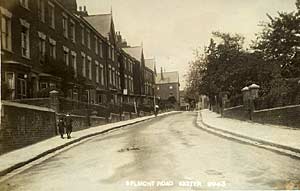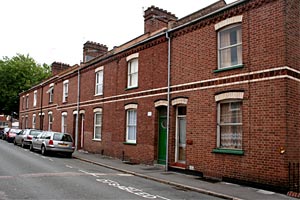
Newtown
Also see Memories of the Newtown blitz
 This area of Exeter between
St Sidwells, and Heavitree has been an area
for the poor from Saxon times. One of the coombes or valleys that
surround Exeter has its source in Chute Street. In Saxon times it was
fast flowing and was used to dispose of human waste, hence its original
name, Shytebrook, and the corrupted Chute Street.
This area of Exeter between
St Sidwells, and Heavitree has been an area
for the poor from Saxon times. One of the coombes or valleys that
surround Exeter has its source in Chute Street. In Saxon times it was
fast flowing and was used to dispose of human waste, hence its original
name, Shytebrook, and the corrupted Chute Street.
Apart from a workhouse, built in the 1671 that stood next to Clifton Road in the Triangle carpark, Newtown was largely rural up until the 19th century. Around about 1700, a new workhouse was built on what is now, the site of Heavitree Hospital, and the old workhouse converted into the City Hospital - many of the fields around Summerlands belonged to this hospital. The City Hospital closed in 1745, after the new Devon and Exeter Hospital opened in Southernhay. It became a bridewell or house of correction, and finally a tapestry factory. In the 1830's, Summerland Street, and Higher and Lower Summerlands were built over the fields that had supplied the hospital with produce.
Brick and jobs
Brick and tile making were carried on in Exeter by the Romans from clay
workings within the city wall. By the 16th century, the rich red clay
of Newtown was exploited for brickworks. In the 19th Century, there was
one large brickworks at Clifton Hill,
and a smaller works just over the border, in Polsloe, next to Park
Road. Many of the workers required for the brickworks would have been
housed in Newtown.
Cholera and
development
The cholera of the 1830's mostly affected the West Quarter, but the epidemic led to
many of the open sewers in Exeter, including the Chute, being covered
over. It was at this time that Clifton Street, John Street East and
Sandford Street were developed, utilising bricks from the nearby
brickworks; many ordinary terrace houses are adorned with some rather
nice, decorative brickwork, attesting to the quality of the local
product.
Clifton Road was originally known as Tanner's Lane, before it was renamed in the 1830s. By the 1850's, construction in these street as well as Albert Street and Belmont Place was complete. Work on Chute Street was started in 1851 and at the end of the 19th century all the residential streets running up to Polsloe Road were in place.
Newtown School was built as a result of the 1870 Education Act, as a board school. On 8th June 1874, the first children entered the school
1942 and all
that...
A high proportion of damaged and destroyed housing after the May 1942
bombing were in Newtown. For example:
'Albert Street - 5 dwelling houses, damaged by fire and H.E.' (high explosives).
'Portland Street - 7 dwelling houses, No's. 2, 4, 7, 21, 40, 42, 66, (2 storey buildings), damaged by fire and H.E.'.
'Clifton Street - 3 shops and dwellings house Nos. 49, 50, 51, 52, and 53 (2 storey), 3 dwelling houses Nos. 46, 47,, 48 (2 storey), St Matthews Hall (1 storey), damaged by fire and H.E.'.
Part of a longer report explains why there was so much damage:
'...The first arrival of the NFS (National Fire Service) in this district is reported at 6 a.m. and this did not help the general situation. Larger apparatus on the spot and more water would have minimised this tremendous damage and the destruction of 600/700 houses.'
In total, some 700 houses were destroyed or badly damaged during the May raid in Newtown. The Clifton Inn, close to the Triangle, and former pub of Tony Kellow the Exeter City footballer, was badly damaged by a bomb crashing through a first floor window - scorch marks from the fire can still be seen in the roof space. The King and Queen made a point of driving along Clifton Road, when they visited the city to view the bomb damage. Some of the streets of terraced housing still show gaps like missing teeth filled with 1950's and 60's style housing, alongside the Victorian and Edwardian terraces. Newtown is now a thriving community with many students from the University living in the area. There is a range of local pubs and shops, and a very good primary school.
Sources: Express and Echo, Exeter Burning by Peter Thomas and other unlogged sources.
 Looking down Clifton Road with the Globe Inn on the right.
Looking down Clifton Road with the Globe Inn on the right.
 Belmont
Road, Newtown before the First War.
Belmont
Road, Newtown before the First War.
 The decorative brickwork on these houses in Portland Street reflect the
proximity of the brickworks.
The decorative brickwork on these houses in Portland Street reflect the
proximity of the brickworks.
Pubs in Newtown Globe Inn - in Clifton Road and Albert Street. The Golden Lion - Clifton Road and Clifton Street. The Clifton Inn - Established in a private house in 1857 when it was at first known as the Clifton House Hotel. One past landlord, Tony Kellow, was a retired Exeter City footballer who had been the clubs highest goal scorer.
│ Top of Page │